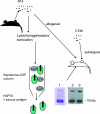Heat shock protein derived from a non-autologous tumour can be used as an anti-tumour vaccine
- PMID: 12941147
- PMCID: PMC1783031
- DOI: 10.1046/j.1365-2567.2003.01726.x
Heat shock protein derived from a non-autologous tumour can be used as an anti-tumour vaccine
Abstract
Antigenic cross-reactivity between certain tumours has allowed the development of more widely applicable, major histocompatibility complex-disparate (allogeneic) whole-cell vaccines. This principle should also allow heat shock proteins (hsp) derived from certain tumours (and carrying cross-reactive antigens) to be used as vaccines to generate anti-tumour immunity in a range of cancer patients. Here, hsp70 derived from gp70-antigen+ B16 melanoma generated cytotoxic-T-lymphocyte-mediated immune protection in BALB/c mice against challenge with gp70-antigen+ CT26 colorectal tumour cells. Using ovalbumin as a model tumour antigen, it is shown that hsp70 enhances peptide re-presentation by dendritic cells via class I over equimolar whole ovalbumin antigen. However, while transfection of tumour cells with inducible hsp70 increases hsp yield from tumours, it does not enhance antigen recognition via purified hsp70 nor via whole cells or their lysate.
Figures




Similar articles
-
Combined use of dendritic cells enhances specific antileukemia immunity by leukemia cell-derived heat shock protein 70 in a mouse model with minimal residual leukemia cells.Int J Hematol. 2006 Dec;84(5):449-58. doi: 10.1532/IJH97.06003. Int J Hematol. 2006. PMID: 17189229
-
Vaccination with a DNA vaccine based on human PSCA and HSP70 adjuvant enhances the antigen-specific CD8+ T-cell response and inhibits the PSCA+ tumors growth in mice.J Gene Med. 2007 Aug;9(8):715-26. doi: 10.1002/jgm.1067. J Gene Med. 2007. PMID: 17595048
-
Development of a novel Hsp70-based DNA vaccine as a multifunctional antigen delivery system.J Control Release. 2010 Mar 19;142(3):411-5. doi: 10.1016/j.jconrel.2009.11.005. Epub 2009 Nov 11. J Control Release. 2010. PMID: 19913062
-
Genetically modified tumour vaccines--where we are today.Cancer Treat Rev. 1999 Feb;25(1):29-46. doi: 10.1053/ctrv.1998.0104. Cancer Treat Rev. 1999. PMID: 10212588 Review.
-
Review: dendritic cell immunotherapy for melanoma.Cancer Biother Radiopharm. 1999 Feb;14(1):11-22. doi: 10.1089/cbr.1999.14.11. Cancer Biother Radiopharm. 1999. PMID: 10850282 Review.
Cited by
-
Heat-shock proteins as dendritic cell-targeting vaccines--getting warmer.Immunology. 2013 Aug;139(4):407-15. doi: 10.1111/imm.12104. Immunology. 2013. PMID: 23551234 Free PMC article. Review.
-
Initiation of the Immune Response by Extracellular Hsp72: Chaperokine Activity of Hsp72.Curr Immunol Rev. 2006 Aug;2(3):209-215. doi: 10.2174/157339506778018514. Curr Immunol Rev. 2006. PMID: 17502920 Free PMC article.
-
Facets of heat shock protein 70 show immunotherapeutic potential.Immunology. 2003 Sep;110(1):1-9. doi: 10.1046/j.1365-2567.2003.01725.x. Immunology. 2003. PMID: 12941135 Free PMC article. Review.
-
Antitumor immunity induced by DNA vaccine encoding alpha-fetoprotein/heat shock protein 70.World J Gastroenterol. 2004 Nov 1;10(21):3197-200. doi: 10.3748/wjg.v10.i21.3197. World J Gastroenterol. 2004. PMID: 15457574 Free PMC article.
-
Heat shock proteins HSP70 and GP96: structural insights.Cancer Immunol Immunother. 2006 Mar;55(3):339-46. doi: 10.1007/s00262-005-0020-y. Epub 2005 Jul 20. Cancer Immunol Immunother. 2006. PMID: 16032399 Free PMC article. Review.
References
-
- Rosenberg SA. Progress in human tumour immunology and immunotherapy. Nature. 2001;411:380–4. - PubMed
-
- Van Der Bruggen P, Zhang Y, Chaux P, et al. Tumor-specific shared antigenic peptides recognized by human T cells. Immunol Rev. 2002;188:51–64. - PubMed
-
- Hanson HL, Donermeyer DL, Ikeda H, et al. Eradication of established tumors by CD8+ T cell adoptive immunotherapy. Immunity. 2000;13:265–76. - PubMed
-
- Chouaib S, Asselin-Paturel C, Mami-Chouaib F, Caignard A, Blay JY. The host–tumor immune conflict. from immunosuppression to resistance and destruction. Immunol Today. 1997;18:493–7. - PubMed
-
- Vermorken JB, Claessen AM, van Tinteren H, et al. Active specific immunotherapy for stage II and stage III human colon cancer: a randomised trial. Lancet. 1999;353:345–50. - PubMed
Publication types
MeSH terms
Substances
LinkOut - more resources
Full Text Sources
Other Literature Sources
Medical

